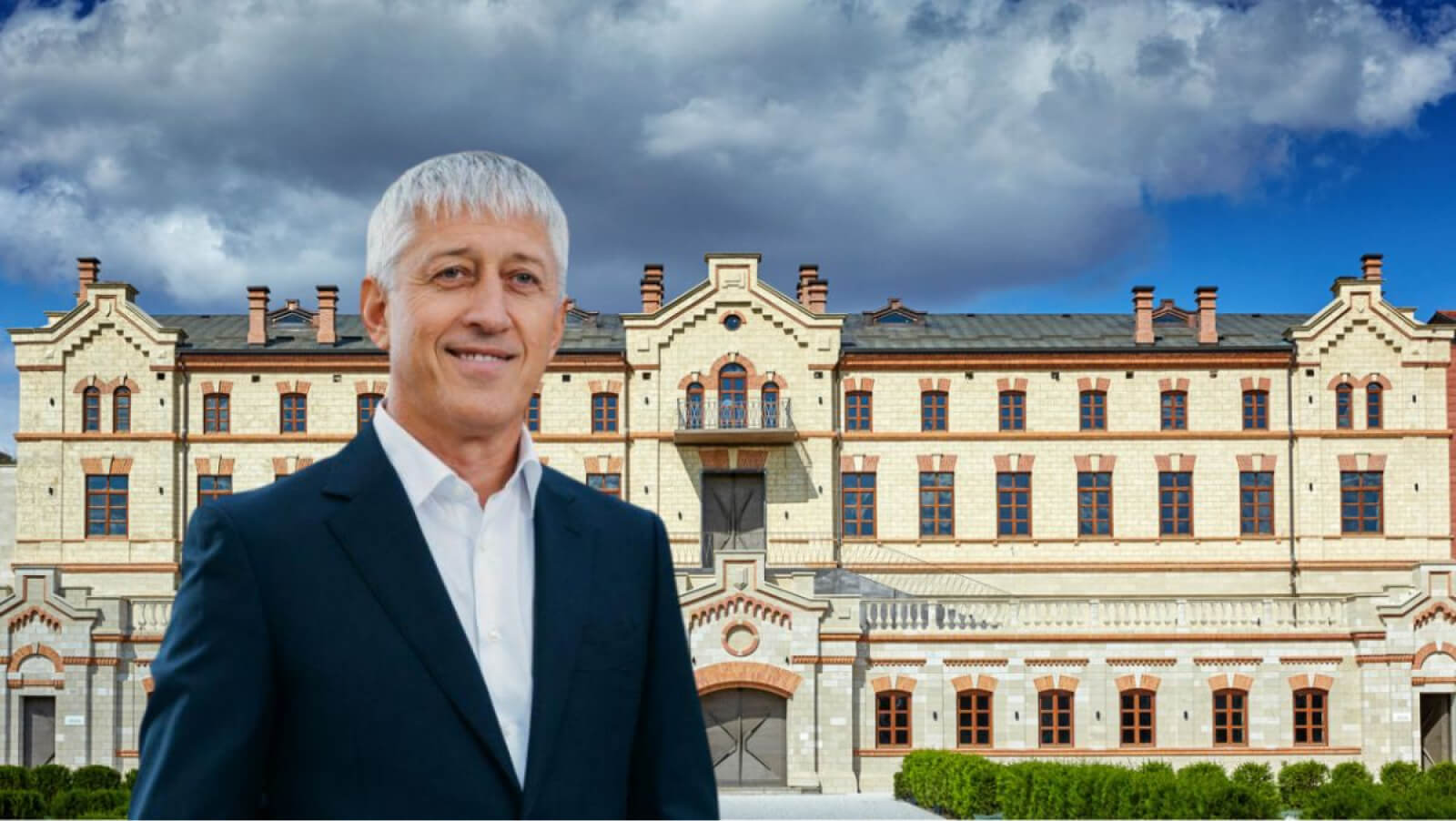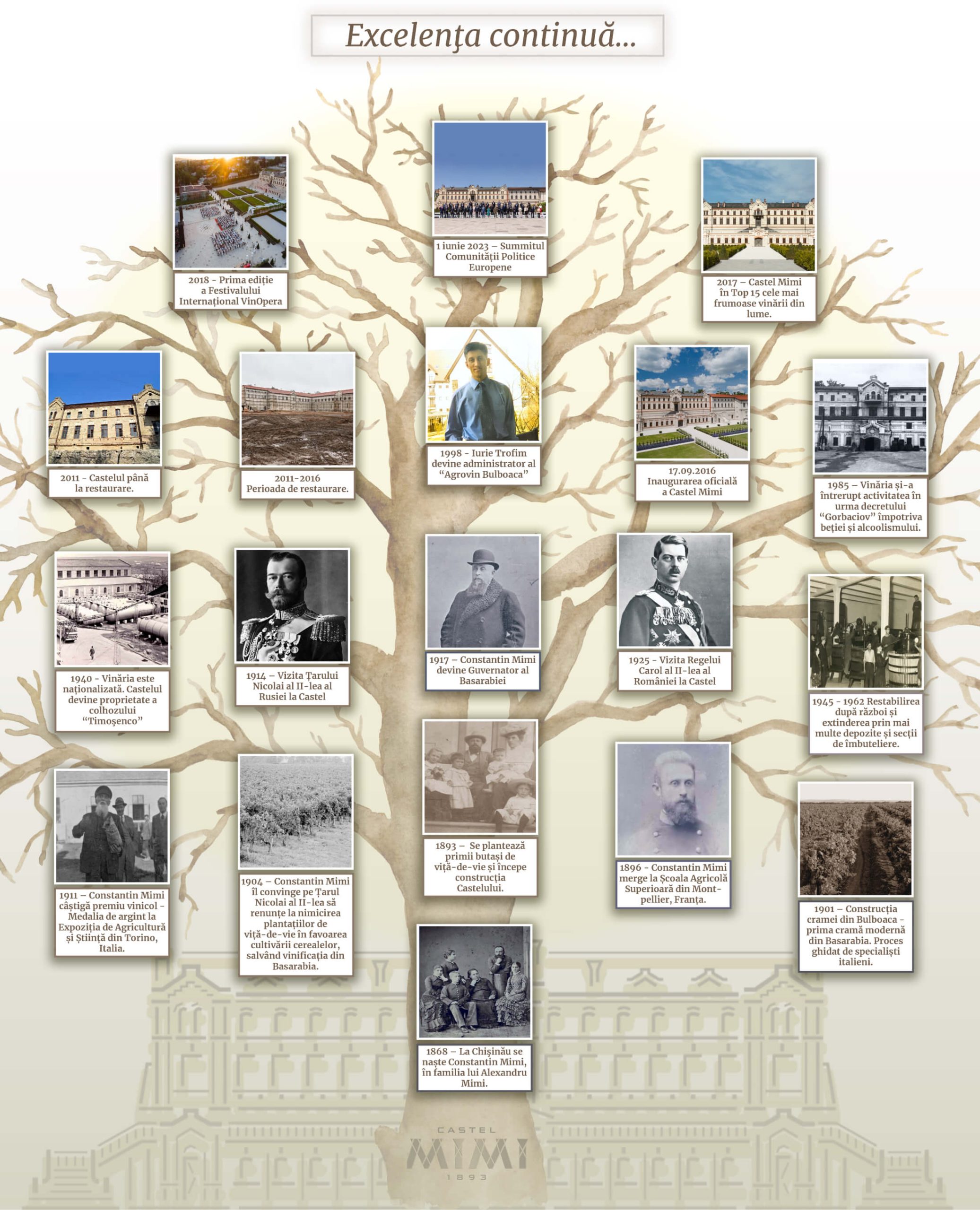
The story of the only castle in the Republic of Moldova – Castle Mimi
September 19, 2023
Some time ago, more than 150 years ago, in Chișinău, Alexandru Mimi’s family gave birth to his only son, whom he named Constantin, in honour of the friendship he had with Prince Constantin Moruzi, former marshal of the Bessarabian nobility, owner of lands and villas in Bessarabia, descendant of the Lord of Moldavia Alexandru Moruzi.
Constantin Mimi turned out to be an ambitious young man determined to pursue his dream of producing wine, other than on peasant farms. Quality wine, made using modern technologies, from carefully selected grapes. At the age of 25, he planted his first vine cuttings on the Bulboaca estate and began producing wine, initially in small quantities, which he sold in Bender.
Also in 1893, he began building what is now Mimi Castle – one of the 15 most beautiful wineries in the world. Constantin Mimi wanted a real French chateau and built it by inviting Italian specialists to Bulboaca, who designed and built the castle. The construction was the first building in Bessarabia built of reinforced concrete, a novelty at that time.
At the same time, young Mimi was studying law at Odessa University, which he graduated with high praise and merit. Already a wine-growing enthusiast, he travels to France, to the Monpellier Agricultural School, where he spends two years studying grape varieties, wines, tastes and production technologies. He understands that for good home-produced wines, you have to change varieties. When he leaves, he takes with him the knowledge, the secrets he has learned and the Aligote grape variety, which arrives in Basarabia for the first time, brought by Mimi.
From here, Mimi’s path in winemaking takes an ascent. He builds a winery in Bulboaca, vineyards quickly spread to neighbouring villages, and the winery starts producing wine in industrial quantities.

In 1904, hundreds of hectares of Mimi’s vineyards, as well as all of Bessarabia, were to be destroyed, at the behest of Tsar Nicolai II, who wanted to cultivate cereals on those lands. With his insistence and determination, Constantin Mimi took part in a competition in Tsarist Russia, won the top prize in agriculture and thus managed to hold a discussion with the Tsar to persuade him to give up the idea. Thus, at just 36 years old and with a bottle of wine from Bulboaca, Constantin Mimi was able to save the wine industry in Bessarabia. A few years later, the Tsar visited the winery and was impressed by the quality of the wines produced by Constantin Mimi, who had vineyards in Bulboaca, Hârbovăț, Speia, Ursoaia and Cobusca.
Constantin Mimi was one of the first Moldovan winemakers to export bulk wines in industrial quantities. In his time, they were appreciated in Moscow and Vladivostok.
The awards speak for themselves – a silver medal in 1911 at the Agricultural and Scientific Exhibition in Turin, Italy, where producers from all over Europe competed, and high praise for one of the three cuvées the winery presented in the Italian city.
Not only were the grapes carefully selected to Constantin Mimi’s specifications, but also the wood for the barrels – only oak and not just any oak. Trees grown in valleys and places rich in humidity were not accepted. Only mountain oaks were used as doage for Mimi’s poloboats. And this for the ‘total harmony’ of the wine.
The quality of the wines and the beauty of the place has attracted high ranking visits since the time of Constantin Mimi, who was host to the Tsar of Russia, but also to the King of Romania, Charles II.
In 1926, Constantin Mimi decided to retire to Bucharest, where he accepted the position of Director of the National Bank of Romania and left the estate to his children. This was the end of his intense activity at Bulboaca.
With the division of the spheres of territorial influence by Tsarist Russia and Nazi Germany and the beginning of the Second World War, the castle was nationalized and became the property of the “Tymoshenko” colony. It is damaged during the fighting and takes years to recover, to begin to record new successes in winemaking in the republic. In the meantime, the territory is being expanded with the construction of an administrative block, warehouses, bottling sections and a laboratory. In 1966, the castle came to life and produced 1256 thousand decalitres of wine, of which 904 thousand decalitres was bottled and exported. Increasingly productive years followed, such as 1981 when just 1,850,000 decalitres of wine were poured into bottles.
A turning point in the castle’s history was to follow just a few years later – in 1985, when the enterprise was forced to cease its activities following Mikhail Gorbachev’s decree declaring war on drunkenness and alcoholism by destroying the vineyards.
The legal name of the winery changed over time, as did its management, which numbered ten. In 1998, Iurie Trofim took over the management of Agrovin Bulboaca, who together with his wife Natalia decided to develop a business that they would pass on to their children – Adrian and Cristina. They thought of wine and wine production and not of a cultural-historical place to discover.

A thread of history, culture and architecture
They were to learn about the importance and value of the place later, by chance, when they tried to repair the facade and the fallen layers opened up the architecture of time and the design of Italian specialists guided by the demanding eye of Constantin Mimi. Thus, after several family councils, it was decided to restore the castle.
Work began in 2011, only after the Trofim family was convinced that they had found the right designer who was not building but restoring an architectural monument of great historical importance and value. Coincidentally or not, the Italian specialists turned out to be the most suitable for such a large-scale work. For five years, Arnaldo Tranti, from the mountainous north of the peninsula, the town of Aosta, has been commuting regularly to Bulboaca.
Arnaldo spent days poring over old photos that captured part or just a corner of the castle. He analysed hundreds of traditional barks and shirts to decipher their symbols. He has been involved in sanding stone and wood to make sure the work is done properly and the colour is just right.
After five years, the Bulboaca site, next to the oldest train station, has been transformed into a stunningly beautiful castle that has opened up a strong vein of culture, history and architecture in the Republic of Moldova.
Mimi Castle – 130 years of culture, creativity and excellence …

